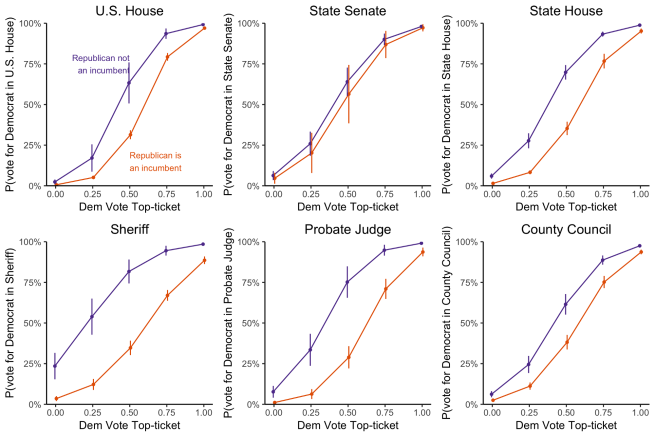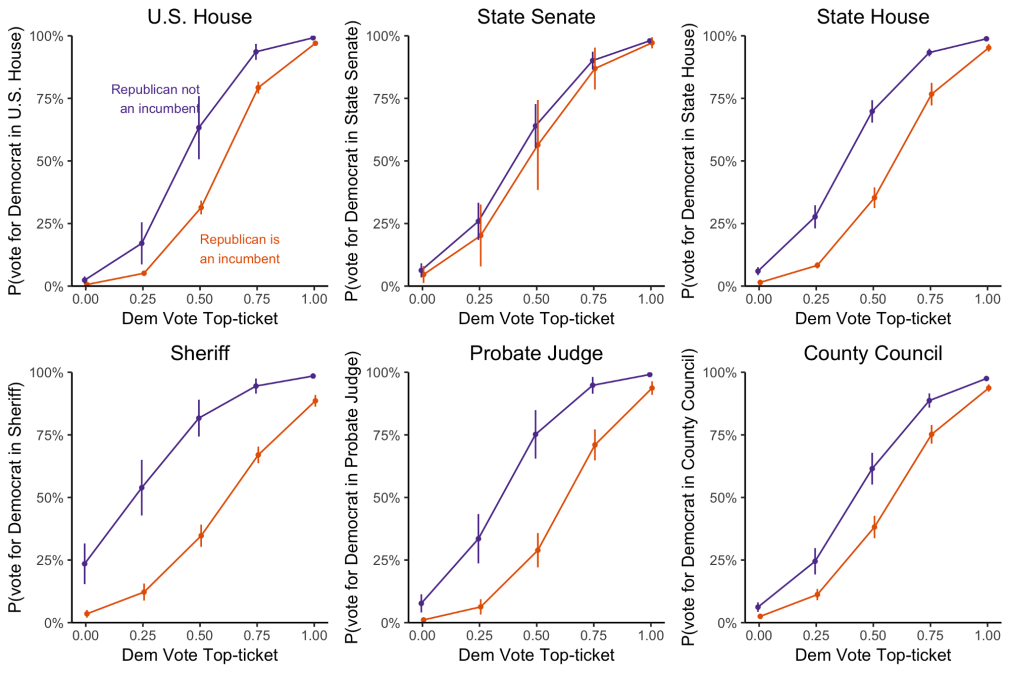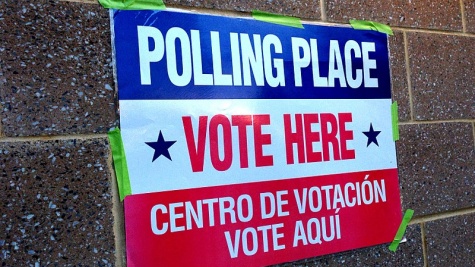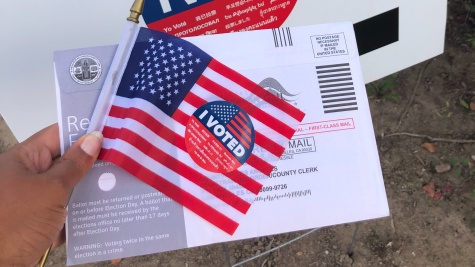Is Ticket Splitting More Prevalent in State and Local Races?
Cast Vote Record in Election Research and Administration
The MIT Election Data and Science Lab helps highlight new research and interesting ideas in election science, and is a proud co-sponsor of the Election Sciences, Reform, & Administration Conference (ESRA).
Shiro Kuriwaki recently presented a paper at the 2019 ESRA conference entitled, “ Party Allegiance on the Long Ballot: Is Ticket Splitting More Prevalent in State and Local Elections?” Here, he summarizes his analysis from that paper.
“Ticket splitting is dead”, proclaimed a Vox headline after the 2016 election.
For the first time since the direct election of U.S. Senators, Republican senate candidates won only in states that Donald Trump carried, and Democratic senate candidates won only in states that Hilary Clinton carried. Two years later, the nationalization of American parties seems to have only accelerated. (For example, see reporting from FiveThirtyEight, as well as a path-setting book by political scientist Daniel Hopkins.)
But virtually all the evidence for the decline of ticket splitting comes from evidence in Presidential, Congressional, and Gubernatorial races. What about all the other races Americans vote on — state legislators, sheriffs, and county councils? Such a seemingly straightforward question turns out to be an empirical quandary. Election returns can only tell us a limited amount of voter’s ticket splitting behavior, a problem long familiar to scholars as the ecological fallacy. The fact that Governor Abbott won Texas by 13 points while Senator Cruz won re-election by 3 points and does not mean that the difference of those two numbers —10 percent —split their ticket: the true answer is most definitely higher. Public opinion surveys are free from the ecological fallacy, but they rarely ask voters about their choices in down ballot offices like the state legislature or county council. Even if they did, reciting dozens of vote choices from memory is a difficult task for anyone.
In my research, I have been creating a dataset of anonymous ballots that can comfortably resolve this question. In a recent working paper, I analyze how much voters in South Carolina split their tickets in state and local offices far down the ballot, and why.
About the Research
The data I use are cast vote records or ballot image logs, which are electronic copies of voting records that most voting machines store when electronic votes are cast or when paper ballots are scanned for tabulation. After reconstructing ballot layouts from these machine logs, I find that in South Carolina, voters defect from their national party allegiance in state and county offices at similar or higher rates than they do in congressional ones. While only 6 percent of the state’s voters split their ticket between the Presidential race and U.S. House contests in 2016, close to 17 percent split parties between Presidential and contested Sheriff races.
Why would voting in state and local races be different from national ones? In my paper, I show that the high degrees of incumbency advantage in state and local elections is one of the clearest explanations. I find that ticket splitting systematically advantages whoever the incumbent is in the race, regardless of their political affiliation. Incumbents generally tend to be better known, run more effective campaigns, and have more job-relevant experience. Even though incumbency status is not written on the ballot (in most states — with exceptions including California, Georgia, and Massachusetts,) and news coverage on local elections tends to be scarce, a sizable number of voters evidently prefer the incumbent in each down ballot race. In other words, not all voters are blind partisans.
Cast vote records open up the possibility of answering other types of research questions. These include possible studies on ticket splitting in ballot measures, party primaries, and school board elections. (Academic work on cast vote records is not new, but fairly rare. Some existing examples look at Ralph Nader voters in Florida, voting in Los Angeles county, and vote choice in ranked choice voting.) But it’s important to acknowledge that the availability of these data rely on the meticulous operations of election administrators. South Carolina is one of the few states in the nation that collects cast vote records from all its counties, and makes them available to the public as a part of their audit. Other states have collected cast vote records for post-election audits, especially statewide audits (in Maryland) and innovative Risk-Limiting Audits (in Colorado and Rhode Island).
As these examples show, the conversations around the use of cast vote records administration is recent and evolving. Several cases in the state courts have grappled (or are ongoing) with how exactly to place these electronic records in the context of election law and open records law. One legal question, for example, is whether cast vote records qualify as “voted ballots”, as copies of voted ballots, or as something entirely different like electronic transcriptions of part of the ballot. (See, for example, Kosmider v. Whitney (N.Y. 2019), Hernandez v. Pima County (A.Z. 2017).) In general, both the transparency of election administration as well as the guarantees of the secret ballot are important, as a recent expert panel in Colarado on cast vote records demonstrated.
The time may be ripe for an accounting of the value of cast vote records in both academic research and election administration. The National Institute of Standards and Technology (NIST) is about to release a common data format that provides a common language for administrators and voting machine vendors to organize all types of data that goes into an election management system, including cast vote records. As a broader part of this project, my collaborators in academia and industry hope to contribute to a community that handles cast vote records from various jurisdictions in a responsible and transparent matter.




